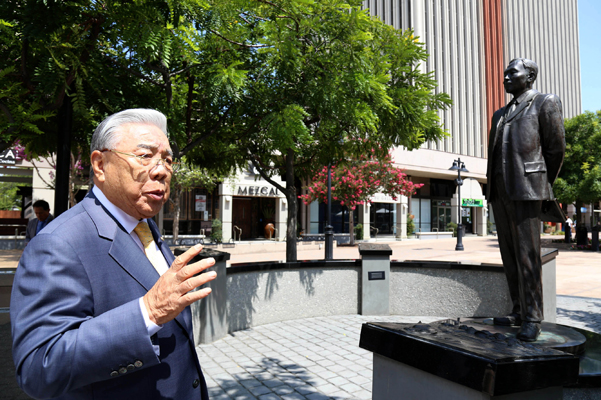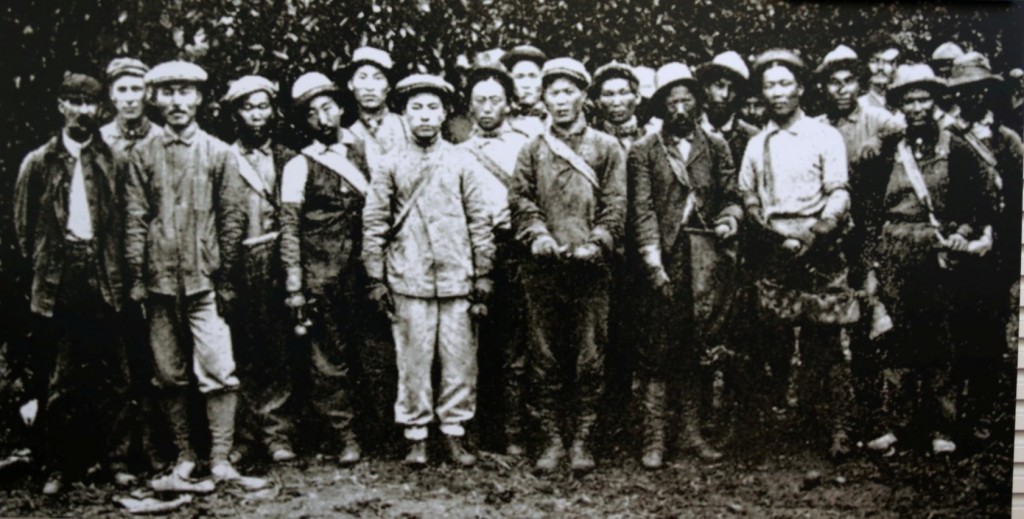- California Assembly OKs highest minimum wage in nation
- S. Korea unveils first graphic cigarette warnings
- US joins with South Korea, Japan in bid to deter North Korea
- LPGA golfer Chun In-gee finally back in action
- S. Korea won’t be top seed in final World Cup qualification round
- US men’s soccer misses 2nd straight Olympics
- US back on track in qualifying with 4-0 win over Guatemala
- High-intensity workout injuries spawn cottage industry
- CDC expands range of Zika mosquitoes into parts of Northeast
- Who knew? ‘The Walking Dead’ is helping families connect
Korea Times Project, part 1A: Riverside, US’ first-ever Koreatown

Bright Future Foundation President Hong Myung-ki, left, next to a statue of Dosan Ahn Chang-ho that stands in front of Riverside City Hall (Choi Kyung-geun/Korea Times)
By The Korea Times Los Angeles staff
The Korea Times recently teamed up with Bright Futures Foundation to explore and celebrate the diaspora of Korean immigrants by visiting 13 culturally significant regions in four different countries. The first stop was Riverside, California.
A statue of Dosan Ahn Chang-ho, a prominent Korean independence activist, stands in front of Riverside City Hall in California.
The city, which emerged as a headquarters for the Korean immigrant community in the early 1900s, was the location of the first Koreatown in the United States.
Immigrants flocked to Riverside to pick oranges on farms, in search of a better life in the midst of Japanese imperalism.
Dosan, too, worked as an orange farm hand there from 1904 to 1907 and again from 1911 to 1914. During that time, the city became home to the country’s largest Korean independence movement.
Dosan helped set up grounds for the community by opening an employment agency, a Korean association, a church and a Korean language school. His statue was installed in 2001.
“Dosan led Riverside’s Korean community and taught them the importance of sincerity in hard work, even while picking oranges,” said Hong Myung-ki, head of the Bright Future Foundation. “It’s a proud feeling, to see that Korean Americans could come together with one mind to erect a statue of Dosan, the man who led this community a century ago.”
The Korean American community looks to celebrate the 70th anniversary of Korean independence from Japanese rule on August 15.

Korean immigrants who worked at an orange farm, including Dosan Ahn Chang-ho, second from left in front row, got together to pose for a photo. The place is believed to be Alta Cresta Grove Farm in Riverside, California. (Korea Times file)












![일본 사도광산 [서경덕 교수 제공. 재판매 및 DB 금지]](http://www.koreatimesus.com/wp-content/uploads/2024/07/PYH2024072610800050400_P4-copy-120x134.jpg)



Philip Cuddy
August 10, 2015 at 8:15 PM
Calling Riverside the first Koreatown is historically incorrect. Saying that Riverside was the largest independence movement city in the country is historically incorrect. Neither Mike Myung Ki Hong or Professor Ed Chang know Korean American history or Dosan’s history very well at all. The statue doesn’t look like Dosan. It looks more like Dr. Seuss because the artist who did it was only given one picture by John Suh instead of letting the artist chose the best picture. The City of Riverside should research the facts instead of letting people who do not know the facts put false information in newspapers. If Mike Myung Ki Hong is this bad at major facts about Korean history how can he run the Korean American Museum. One reason he doesn’t know anything because his legacy is more tied to Japanese as a chinilpa family member. He is not a patriot of any kind.